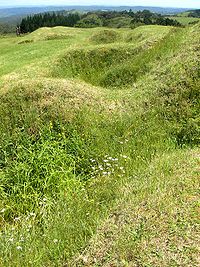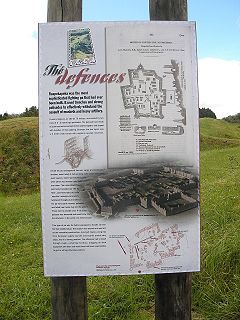
Ruapekapeka
Encyclopedia
Ruapekapeka is a pā
14 kilometres southeast of Kawakawa
in the Northland Region of New Zealand
. It is one of the largest and most complex pā in New Zealand, that was designed specifically to counter the cannon
s of the British forces. The earthworks can still be seen just south of Kawakawa
. Ruapekapeka was the site of the last battle in the Flagstaff War
Ruapekapeka was the site of the last battle in the Flagstaff War
, between British
troops and the Ngāpuhi
, which was the first major armed conflict between British
troops and the Māori.

Te Ruki Kawiti designed the pā
(fort) of Ruapekapeka (or the Bat's Nest) as a further development of what is now called the gunfighter pa design that was used at the Battle of Ohaeawai
. It was constructed during 1845, in an good defensive position, in area of no strategic value, well away from civilians, as a challenge to British rule. When the new British Governor Sir George Grey
was unable to end the Flagstaff War
by negotiation, he assembled a British force in the Bay of Islands to deal with Hone Heke
and Te Ruki Kawiti. In early December 1845 the British force moved by sea, and began a two week advance over 20 km to bring artillery up to the pa. Bombardment and an incomplete siege commenced on 27 December, (the British lacking the manpower to completely surround the pa). Several weeks of siege punctuated by skirmishing followed.
Early on the morning of Sunday, 11 January 1846, a British foraging party noted the defenders were unusually quiet. The small group of British troops pushed over the palisade and entered the pā finding it almost empty. They were reinforced, while Māori tried to re-enter the pā from the back. After a four hour gun fight, the remaining Maori withdrew, abandoning the pa. Twelve British were killed and twenty nine injured. Maori casualties are unknown, (Heke and Kawiti later said they had lost around 60 dead during the whole of the campaign). Lieutenant Colonel Despard claimed the outcome as a "brilliant success". The casualties in the British forces were 3 soldiers killed and 11 wounded; 2 marines killed and 10 wounded; and 9 seamen killed and 12 wounded.
 Later examination of the pā showed that it had been very well designed and very strongly built. In different circumstances it could have been a long and costly siege. Lieutenant Balneavis, who took part in the siege commented in his journal(dated 11 January):
Later examination of the pā showed that it had been very well designed and very strongly built. In different circumstances it could have been a long and costly siege. Lieutenant Balneavis, who took part in the siege commented in his journal(dated 11 January):
The reason why the defenders abandoned but then re-entered the Pa is unknown. It has been suggested by liberal historians that most of the Māori had been at church, and had not expected the Christian British to attack on a Sunday. However essentially the same warriors had earlier fought on Sunday at the Battle of Ohaeawai
. An alternative suggestion is that there was a plan to ambush the British which miscarried, presumably when the British did not pursue retreating Maori into the bush. However this does not explain why Kawiti remained behind, and was apparently caught unaware by the British assault. It is possible internal differences had overtaken the besieged.
's argument that clemency was the best way to ensure peace in the North. Heke and Kawiti were pardoned and no land was confiscated.
Pa (Maori)
The word pā can refer to any Māori village or settlement, but in traditional use it referred to hillforts fortified with palisades and defensive terraces and also to fortified villages. They first came into being about 1450. They are located mainly in the North Island north of lake Taupo...
14 kilometres southeast of Kawakawa
Kawakawa, New Zealand
Kawakawa is a small town in the Northland Region of northern New Zealand. It had a population of 1347 at the 2006 census, down from 1401 in 2001. Kawakawa developed as a service town when coal was found in the area in 1861, but there is no longer coal mining here...
in the Northland Region of New Zealand
New Zealand
New Zealand is an island country in the south-western Pacific Ocean comprising two main landmasses and numerous smaller islands. The country is situated some east of Australia across the Tasman Sea, and roughly south of the Pacific island nations of New Caledonia, Fiji, and Tonga...
. It is one of the largest and most complex pā in New Zealand, that was designed specifically to counter the cannon
Cannon
A cannon is any piece of artillery that uses gunpowder or other usually explosive-based propellents to launch a projectile. Cannon vary in caliber, range, mobility, rate of fire, angle of fire, and firepower; different forms of cannon combine and balance these attributes in varying degrees,...
s of the British forces. The earthworks can still be seen just south of Kawakawa
Kawakawa, New Zealand
Kawakawa is a small town in the Northland Region of northern New Zealand. It had a population of 1347 at the 2006 census, down from 1401 in 2001. Kawakawa developed as a service town when coal was found in the area in 1861, but there is no longer coal mining here...
.

Flagstaff War
The Flagstaff War – also known as Hone Heke's Rebellion, the Northern War and erroneously as the First Māori War – was fought between 11 March 1845 and 11 January 1846 in and around the Bay of Islands, New Zealand...
, between British
British people
The British are citizens of the United Kingdom, of the Isle of Man, any of the Channel Islands, or of any of the British overseas territories, and their descendants...
troops and the Ngāpuhi
Ngapuhi
Ngāpuhi is a Māori iwi located in the Northland region of New Zealand, and centred in the Hokianga, the Bay of Islands and Whāngārei.Ngāpuhi has the largest affiliation of any New Zealand iwi, with 122,214 people registered , and formed from 150 hapu, with 55 marae.-Foundations:The founding...
, which was the first major armed conflict between British
British people
The British are citizens of the United Kingdom, of the Isle of Man, any of the Channel Islands, or of any of the British overseas territories, and their descendants...
troops and the Māori.
Battle of Ruapekapeka Pa

Te Ruki Kawiti designed the pā
Pa
-Places:* Pâ, a town in Burkina Faso* Pâ Department, a department in Burkina Faso* PA postcode area, in Scotland* Province of Palermo, Italy* Palo Alto, California* Panama, ISO country code** .pa, the country code top level domain for Panama...
(fort) of Ruapekapeka (or the Bat's Nest) as a further development of what is now called the gunfighter pa design that was used at the Battle of Ohaeawai
Battle of Ohaeawai
The Battle of Ohaeawai was fought between British forces and local Māori during the Flagstaff War in July 1845 at Ohaeawai in the North Island of New Zealand...
. It was constructed during 1845, in an good defensive position, in area of no strategic value, well away from civilians, as a challenge to British rule. When the new British Governor Sir George Grey
George Edward Grey
Sir George Grey, KCB was a soldier, explorer, Governor of South Australia, twice Governor of New Zealand, Governor of Cape Colony , the 11th Premier of New Zealand and a writer.-Early life and exploration:...
was unable to end the Flagstaff War
Flagstaff War
The Flagstaff War – also known as Hone Heke's Rebellion, the Northern War and erroneously as the First Māori War – was fought between 11 March 1845 and 11 January 1846 in and around the Bay of Islands, New Zealand...
by negotiation, he assembled a British force in the Bay of Islands to deal with Hone Heke
Hone Heke
Hone Wiremu Heke Pokai was a Māori rangatira and war leader in Northern New Zealand and a nephew of Hongi Hika, an earlier war leader of the Ngāpuhi iwi. Hone Heke is considered the principal instigator of the Flagstaff War....
and Te Ruki Kawiti. In early December 1845 the British force moved by sea, and began a two week advance over 20 km to bring artillery up to the pa. Bombardment and an incomplete siege commenced on 27 December, (the British lacking the manpower to completely surround the pa). Several weeks of siege punctuated by skirmishing followed.
Early on the morning of Sunday, 11 January 1846, a British foraging party noted the defenders were unusually quiet. The small group of British troops pushed over the palisade and entered the pā finding it almost empty. They were reinforced, while Māori tried to re-enter the pā from the back. After a four hour gun fight, the remaining Maori withdrew, abandoning the pa. Twelve British were killed and twenty nine injured. Maori casualties are unknown, (Heke and Kawiti later said they had lost around 60 dead during the whole of the campaign). Lieutenant Colonel Despard claimed the outcome as a "brilliant success". The casualties in the British forces were 3 soldiers killed and 11 wounded; 2 marines killed and 10 wounded; and 9 seamen killed and 12 wounded.

- "Pa burnt. Ruapekapeka found a most extraordinary place,--a model of engineering, with a treble stockade, and huts inside, these also fortified. A large embankment in rear of it, full of under-ground holes for the men to live in; communications with subterranean passages enfilading the ditch. Two guns were taken,--a small one, and an 18-pounder, the latter dismantled by our fire. It appeared that they were in want of food and water. It was the strongest pa ever built in New Zealand."
The reason why the defenders abandoned but then re-entered the Pa is unknown. It has been suggested by liberal historians that most of the Māori had been at church, and had not expected the Christian British to attack on a Sunday. However essentially the same warriors had earlier fought on Sunday at the Battle of Ohaeawai
Battle of Ohaeawai
The Battle of Ohaeawai was fought between British forces and local Māori during the Flagstaff War in July 1845 at Ohaeawai in the North Island of New Zealand...
. An alternative suggestion is that there was a plan to ambush the British which miscarried, presumably when the British did not pursue retreating Maori into the bush. However this does not explain why Kawiti remained behind, and was apparently caught unaware by the British assault. It is possible internal differences had overtaken the besieged.
Aftermath of the battle of Ruapekaeka
The battle marked the end of the Flagstaff War. Kawiti and Heke both sought peace. Grey faced new threats in the south, would have had logistical difficulties in a lengthy campaign himself, and may have underestimated the difficulties the essentially part time Maori force had in continuing a longer campiagn. Grey accepted Tāmati Wāka NeneTamati Waka Nene
Tāmati Wāka Nene was a Māori rangatira who fought as an ally of the British in the Flagstaff War.-Origin and mana:...
's argument that clemency was the best way to ensure peace in the North. Heke and Kawiti were pardoned and no land was confiscated.

